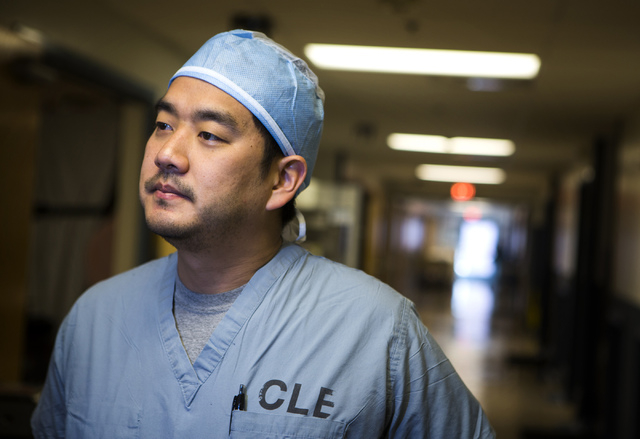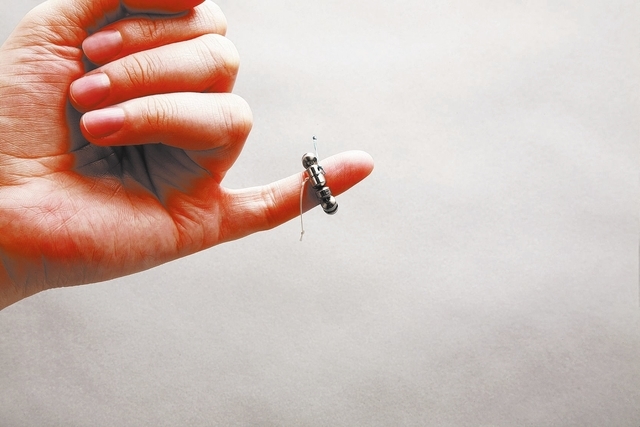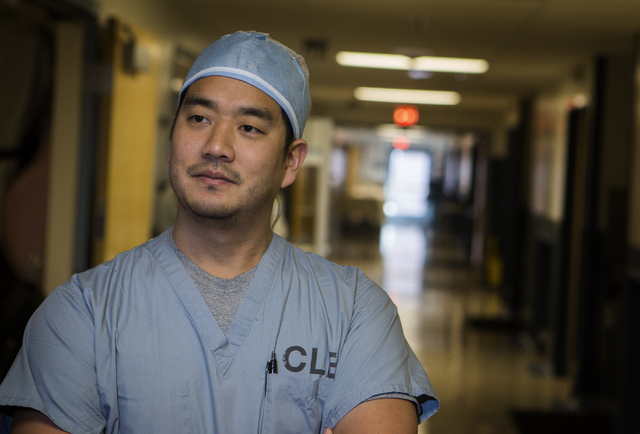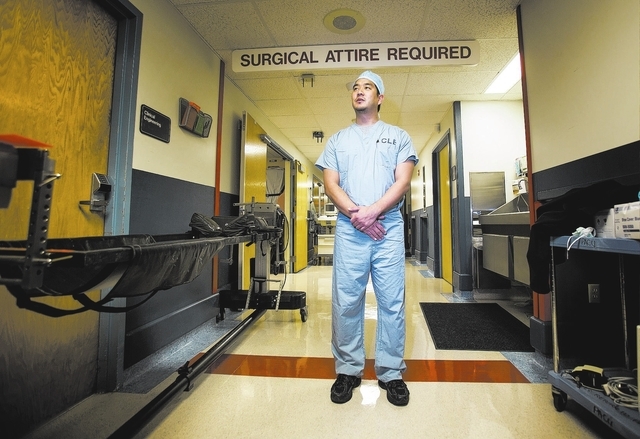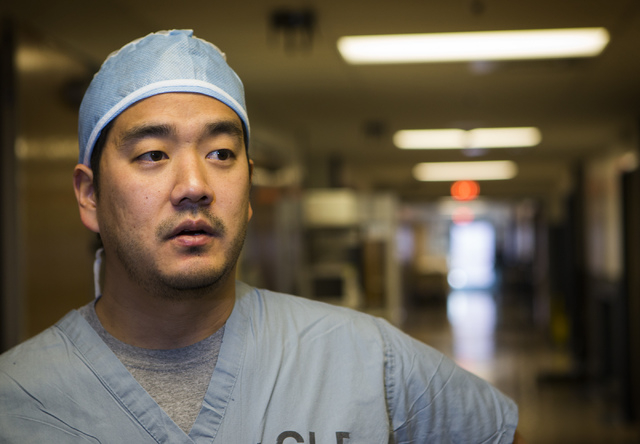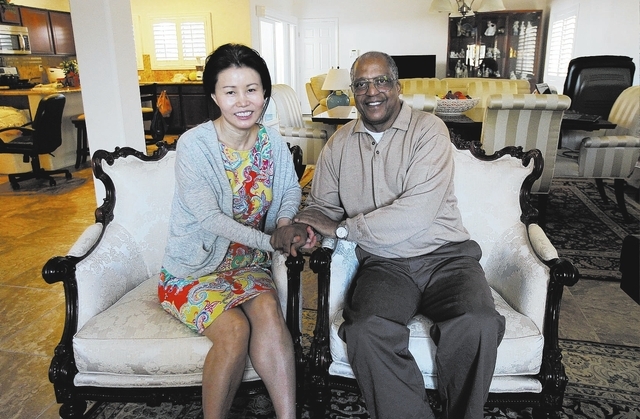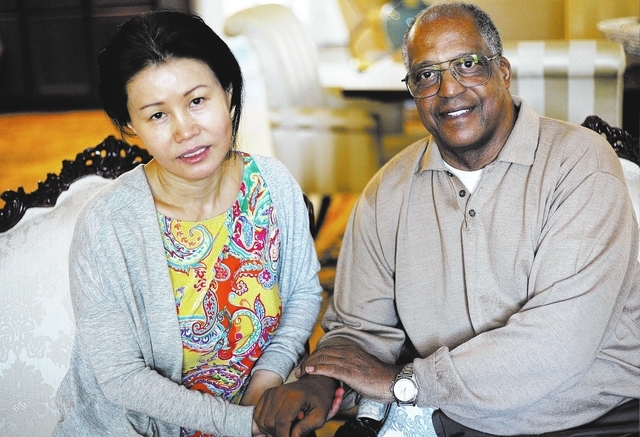Surgically inserted band of beads helps stop acid reflux
The longer Wol Thomas sits at her piano playing the “Ballade pour Adeline,” a gentle, sweet piece of music, the broader she smiles.
“She hadn’t felt like playing for some time,” her husband, Joe, whispers. “She just didn’t feel well.”
Thomas can again indulge her passion for piano playing because a Las Vegas surgeon inserted a tiny band of magnets around her esophagus to treat her acid reflux.
For almost a decade, Thomas, a 50-year-old mother of two grown children, has suffered from gastroesophageal reflux disease, or GERD. Researchers say about 20 million Americans suffer from the condition, which is best known by its symptoms: burning in the throat and chest, sometimes lasting for hours after eating; chronic hoarseness; chest pain; the feeling of food “sticking” in the chest or throat.
A weak esophageal sphincter, or muscle, causes the havoc. When it doesn’t close as it should, harsh stomach juices splash back into the throat and acid reflux makes its painful presence known.
Thomas also had severe side effects from medications she took to ameliorate her condition. Drugs reduce acid but don’t fix the underlying problems.
“From the (prescription) medications I’d get terrible cramping in my legs, have a stiff neck and feel cold all over,” Thomas says. “I definitely wasn’t getting any better. My voice even changed.”
As her symptoms worsened in recent years, she began to eat little more than rice. If she ate the spicy foods she loved, she’d end up trying to sleep sitting up to keep her dinner down.
Then, her local gastroenterologist referred her to Dr. Shawn Tsuda, a 36-year-old Harvard-schooled surgeon and the only practitioner in Nevada trained to perform the LINX procedure approved by the Food and Drug Administration in 2012.
In 38 minutes, Tsuda made Thomas’ long struggle with acid reflux a memory.
He implanted the LINX Reflux Management System, a tiny magnetic bracelet that reinforced the weak muscle at the base of Thomas’ esophagus. She went home the same day.
“The day after surgery, I no longer had to take medicine and I haven’t had any symptoms of acid reflux since,” Thomas says as she sits on the couch in the couple’s southwest Las Vegas home. “I’ve had some difficult swallowing, but it’s getting better every day.”
As he stood outside a Sunrise Hospital operating room, Tsuda explained the minimally invasive procedure that allowed him to access the esophagus through small laparoscopic incisions in Thomas’ abdomen. He then placed a small flexible band of titanium beads — each bead has a magnet inside — around the esophagus’s outer circumference.
The magnetic attraction between the beads helps the sphincter to stay closed, preventing reflux. But swallowing food overcomes the magnetic attraction, allowing the beads to separate so food and drink can pass normally into the stomach. About ½ inch in diameter, the ring expands to about 1½ inches.
At first, a patient may have, as Thomas has had, some difficulty swallowing after the surgery, Tsuda says.
“What it does as people swallow is calibrate to the right size,” he says. “We want most patients to return to a normal diet within 24 hours after the procedure.”
Thomas no longer uses antacids and eats whatever she wants. She can also drink coffee again.
“It’s hard to believe,” she says.
Though Tsuda says most people with acid reflux have mild cases that can be controlled with medication, he stresses that the condition must be treated. Untreated, chronic acid reflux raises the risk of a serious disorder known as Barrett’s esophagus, which in turn can raise the risk of esophageal cancer. In Barrett’s esophagus, tissue in the food tube changes to tissue that resembles the intestinal lining.
In the past, when surgery was necessary to fight GERD, Tsuda performed fundoplication surgery, an up-to-two-hour procedure in which the stomach’s upper curve (the fundus) is wrapped around the esophagus before being sewn into place so that the lower part of the esophagus runs through a tiny tunnel of stomach muscle.
Although this surgery stops acid from backing up into the esophagus as easily, patients who have it can spend several days in the hospital and may be off work for a month — quite a difference from the outpatient LINX procedure that generally has people back at work in about a week.
“In the fundoplication surgery, which has been around since the 1940s, I’m cutting things and moving things around,” Tsuda says. “It changes and distorts the anatomy. Gastroenterologists don’t like what it does to their patients.”
John Sliney, a Las Vegas trucking company manager who’s suffered with acid reflux for years, hasn’t been happy with medications used to regulate his problem, but he didn’t like the fundoplication surgery as an alternative.
“I just think it disturbs your physiology too much,” says Sliney, a 51-year-old who participates in triathlons. “The LINX procedure is so noninvasive.”
Sliney had hoped to have the new surgery done several months ago but his insurance wouldn’t cover it.
“They’d only cover the old procedure at first, but they’ve finally come around,” he says. “Now I’m having the procedure done on Valentine’s Day.”
More than 20 patients are now signed up for the surgery, says Tsuda, who performs the procedure only at Sunrise Hospital.
A 2013 study in the New England Journal of Medicine followed 100 people who had the LINX device implanted during clinical trials. The study found 86 patients no longer needed acid-lowering medicines within one year. After three years, the study said, 94 patients reported they were generally satisfied with their reflux condition compared with 13 before the implant.
The most frequent side effect was difficulty swallowing, which occurred in 68 patients right after surgery. That number dropped to 11 in a year and four after three years.
Six of the 100 patients needed to have the device removed, mainly because swallowing problems persisted.
The device is intended to be permanent. But Tsuda says that because it is so new there are no 10-year studies showing whether it will wear out and need replacing.
“At this point, it appears to be a device that will not weaken over time,” Tsuda says. “But it is a good thing that it is reversible if necessary.”
Reporter Paul Harasim can be reached at pharasim@reviewjournal.com or 702-387-2908.



